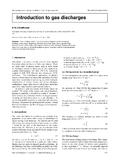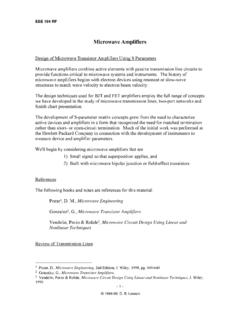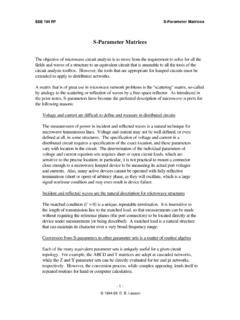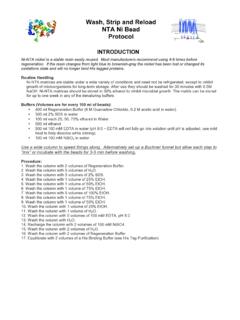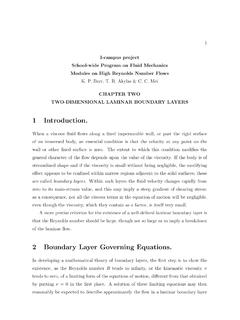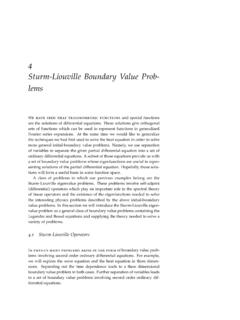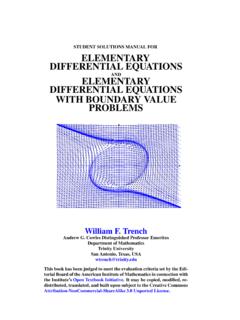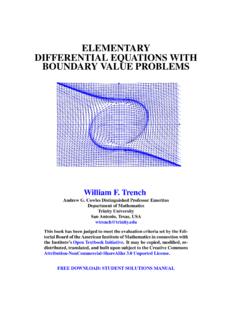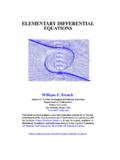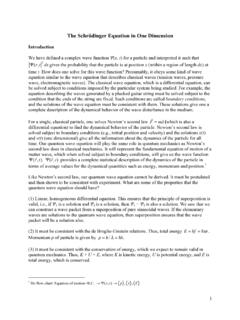Transcription of Boundary Conditions on - University of San Diego
1 Boundary Conditions on Chapter 9rrrrEHDB,,,General Boundary Conditions : Summary of Results Derivation of these most general forms is in the text, Chapter 4-9 and 5-7. Study them carefully. In what follows in these notes, we give the derivations of the same four Boundary Conditions for two important special cases. That is, (a) dielectric to perfect conductor Boundary , and (b) general medium to general medium Boundary with no surface charges and surface current are two ways to solve electromagnetic problems:1. Find out charge and current distributions everywhere in space and solve Maxwell s Equations Solve Maxwell s Equations in a limited region of interest, subject to Boundary Conditions on the boundaries defining this region. Boundary condition means the value of the fields just at the Boundary second method is used most often.
2 It is especially useful when the boundaries are conductors. Boundary Conditions at perfect conductors are fairly simple. We usually approximate good conductors as perfect conduc-tors in this formScalar electric field,, discontinuity of the tan-gentialfield equals the sur-face discontinuity of the normalequals the surface normal component of =HH jtts12 =DDnn s12-=rBBnn120 =$eEEn -=rr120di$eHH jns -=rr r12di$eDDns -=rr12dir$eBBn -=rr120diBoundary Conditions at a Surface of Perfect ConductorChapter 4-9 TextFields inside conductor are zero: .1. Boundary condition for tangential component of electric field:Area enclosed is infinitely small. Therefore RHS . and are infinitely small. Therefore, and . (inside conductor) is zero. Therefore, .This leaves: If ab distance is finite, but small, then is constant, and we have:Thus.
3 In vector form, this can be written:rrEH2200==,rrrrrrrrrrEdlEdlEdlEd lddtBdsdacdbcababcd +++ =-zzzzzabcd12 Perfect ConductorDielectric (perfect, or lossy)s= rrEH2200==, 0adcbabzdaz 0TE2cdz 0rrEdlab =z0rE;Et = 0Et=rEabalongcomponent , tangential componentEt=0, whereis unit normal.$en$eEn =r0A very important corollary of this Boundary condition is that, since at the surface of a perfect conductor, between any point on or inside the conductor. Therefore, a perfect con-ductor is an equipotential Boundary condition for tangential component of magnetic field:Text, 5-7 The second term on the right hand side goes to zero, since the area is infi-nitely small. However, the first term on the right hand side does not go to zero. The reason is that, although the area is infinitely small, can be infinitely large.
4 This means that a surface current can exist on the Boundary , normal to the area abcd. We have already discussed this current enclosed in the area abcd then is . The direction of must be into the paper if on ab is in the direction. Then, the left hand side becomes (by the same reasoning as in 1):Et=0rrEdlab z=0rrrrrrHdlj dsddtDdsabcdabcd =+zzz$end 0 drjsabcdxxxxxxxxxxxxxxxxxxxxxxxxxxxxis small,but finiterjrjsUV|W|rjsjjs= rrdrd 0rj finite jsjsHtab rrHdl Htab =zDThus, 3. Boundary condition on normal component of electric field:If there is only a volume charge density, the right hand side would be zero, since the volume of the box is infinitely , there can be a surface charge density on the surface of the con-ductor.
5 Because of that:The integral of over the side surface is zero, since its height is infini-tesimal. The integral over the bottom surface is zero because the field is zero =. =Hjts$enbgA, oris outward normalThis also givescorrect direction$eH jns =rr$en$n(is frequently written more simply asThis is the notation our text uses.)volume of boxzsurface of boxzUV|W|infinitesimal thicknesssmall, but finite, aread ArdvrrDds =bottomzright hand sideleft hand sideside surfacezrrDdstop +zrrDds rrDds +== DAsrrrDds Note that is positive for pointing outward, as it should be (Field lines originate on positive charges).4. Boundary condition on normal component of magnetic field:We apply to the same pillbox as in , obviously, since RHS , we get:Summary of At the surface of a perfect conductor: Boundary Conditions at Boundary between two dielectrics (or two gen-eral media).
6 No surface charges or currents: We use exactly the same methods as we did in the previous sections. The main difference are that:a. There are fields on both sides of the Boundary , since only inside per-fect conductors are the field s Under normal Conditions , there is no surface charge on the There is no surface current on Boundary , since surface currents can exist only on a perfect conductor Tangential Electric Field Component:\== zLHSrrDds D AtopnDrDDDAADsnr=Dns=r$eDns =rr, orThus,positive, ifis pointing awayfrom conductor srDrrBds =z0=0Bn=0$eBn =r0, component ofsurface current component ofsurface charge component ofE=0rH=rD=rB=0Bn=0Et=0 Hjts=Dns=r$eEn =r0$eHjns =rr$eDns =rr$eBn =r0 Tangential component ofrssj==00,2. Tangential Magnetic Field Component: 3.
7 Normal Electric Field Component: 4. Normal Magnetic Field Component:Same as 3. 5. Examples Useful for Remembering 2. and 3. rEt1rEt2abcdrrrrEdlEdlcdab +=zz0rrEEtt120DD-=\=rrEEtt12$eEEn - =rr120di12, orHHtt12=$eHHn - =rr120dijs=0 Since, we get the same result as in 1., or,rs=0bottomzrrDdstop +zrrDds =0 Since, or$eDDn -=rr120diDDnn12=BBnn12=$eBBn -=rr120di, or ++++++++123123parallel platecurrentsparallel platecapacitorH=0H=0E=0E=0Es=re/Hjs= More on Boundary ConditionsA. It can be easily shown that an equivalent form of Boundary Condition 1. (that is, tangential continuous: ) is: That is, potential is continuous at an Consider , which is the Boundary condition for the normal component of the electric displacement at the interface between a per-fect conductor and a : where means the normal derivative (that is, derivative in the direc- tion of the normal out of the conducting surface).
8 Example shortly!C. If the value of the potential V is given on a conducting surface, that too is called a Boundary condition (to Laplace s Equation). rEEEtt12=VV12=$eDns =rrrrDE=erEV=- \=-re sVnEeVVnnn=- =- $ , V

